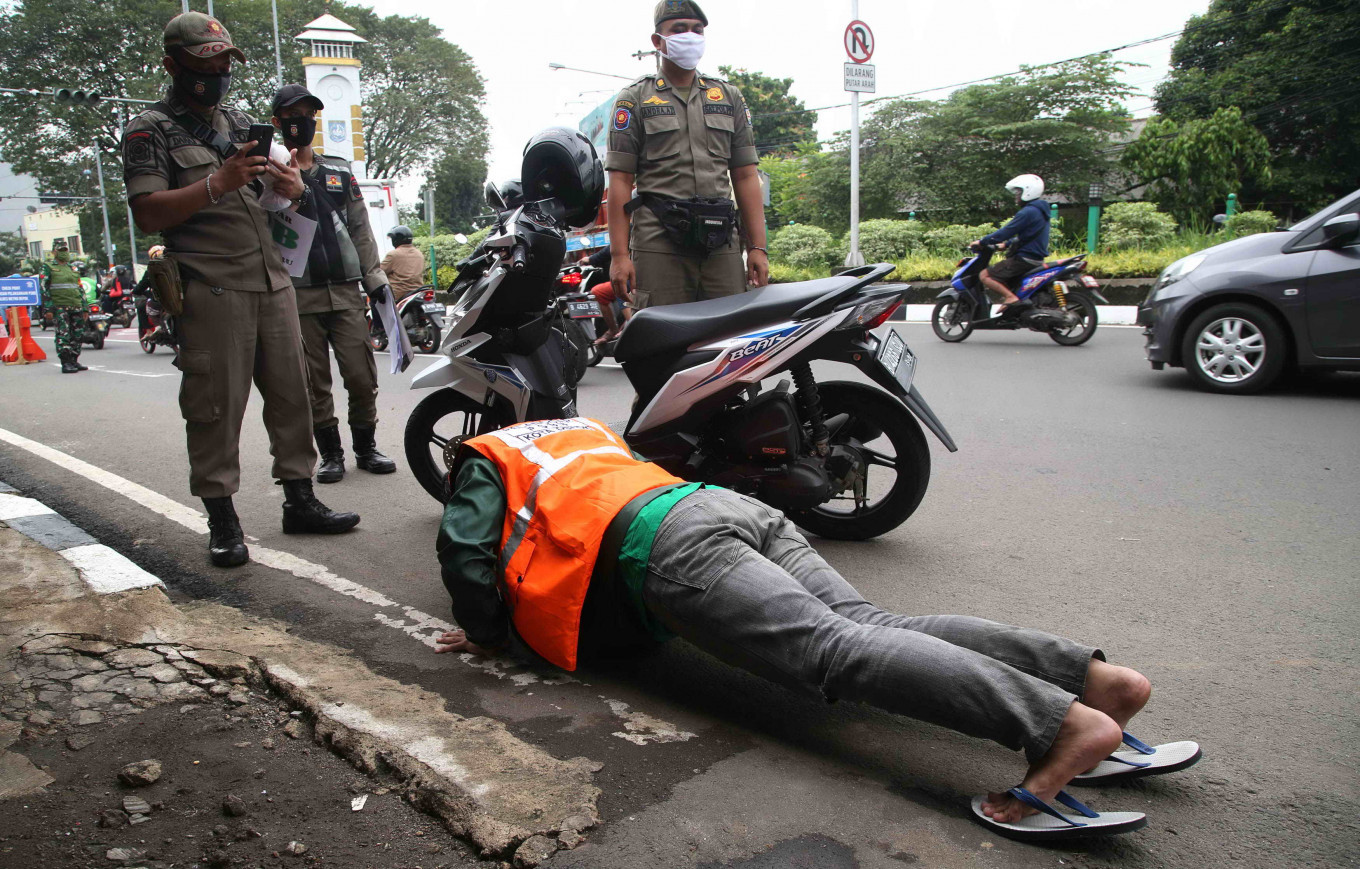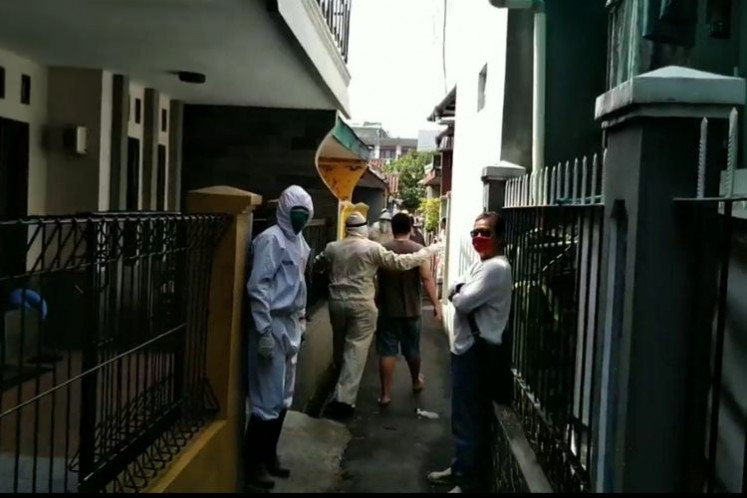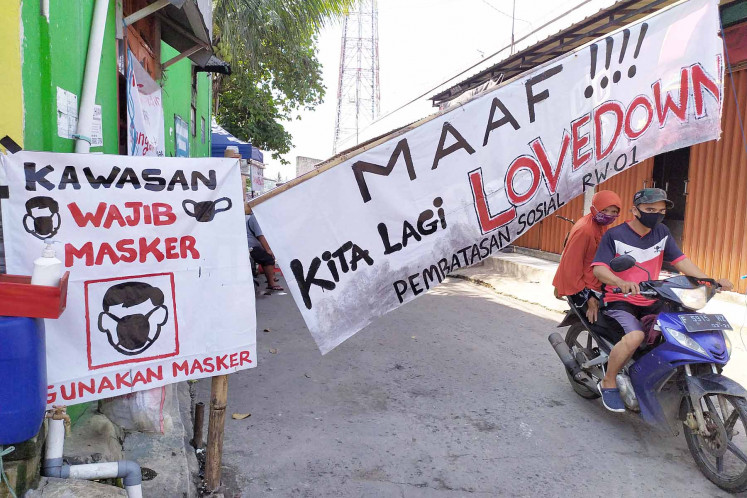Popular Reads
Top Results
Can't find what you're looking for?
View all search resultsPopular Reads
Top Results
Can't find what you're looking for?
View all search resultsWest Java looks to ease curbs despite tallying dozens of new cases
Change text size
Gift Premium Articles
to Anyone
W
est Java, being a close neighbor of Jakarta, has been among the provinces hardest hit by COVID-19, but it is looking into easing curbs in "low-risk" areas after claiming that large-scale social restrictions (PSBB) have yielded desirable results.
The province recorded 40 new cases on Friday, bringing the total confirmed cases to 2,002 with 125 fatalities and 432 recoveries, according to the central government's tally. This has led the province to become the third hardest-hit province after Jakarta and East Java.
"I believe the pandemic is related to density, it's a density disease. The more dense the area is, the more cases are likely to be found," West Java Governor Ridwan Kamil said during a recent online discussion with foreign ambassadors.
“The majority of cases [...] occurred in Greater Jakarta.”
The province is home to around 49 million people, some 33 percent of whom can be found in Jakarta's satellite cities, where people who work in the capital city commonly reside.
Data from the administration shows that cases in Jakarta's satellites accounted for at least 60 percent of the province’s total cases as of Friday, while West Java's capital Bandung city recorded 271 cases and 31 fatalities, the highest number of deaths in the province.
Tight corridors: Medical workers in protective gear escort a man who tested positive for COVID-19 to a hospital in Tasikmalaya, West Java, on May 15. (Kompas.com/Irwan Nugraha)The PSBB have been in place in West Java since May 6, and they are expected to last until May 29, although Bogor, Depok and Bekasi – satellite regions of Jakarta – put curbs in place much earlier on April 15. Greater Bandung also first imposed the PSBB on April 22.
It has identified five infection clusters so far: a seminar of the National Police’s Officer Candidate School in Sukabumi; the Bethel Church of Indonesia (GBI) in Lembang; an anti-usury seminar in Bogor; a religious seminar held by the Protestant Churches of Western Indonesia (GPIB) in Bogor; and a West Java youth entrepreneurs forum in Karawang.
Read also: National COVID-19 task force chief urges public to obey PSBB to pave way for 'new normal'
Recently, local health authorities said they were still tracing contacts from the first two clusters and ramping up efforts to scale up their polymerase chain reaction (PCR) testing capacity.
The province had tested some 10,791 people so far, a very low number that made it difficult to effectively capture the scale of the outbreak and decide on the necessary intervention measures, said epidemiologist Panji Hadisoemarto from Padjadjaran University in Bandung.
This also applies to measuring the province's effective reproduction number (Re), which Governor Ridwan revealed to be 1.04 as of May 15. The effective reproduction number refers to the number of secondary cases per infectious case in a population, with a number below 1 indicating the epidemic is under control and in decline.
“There must be adequate contact tracing, testing [...] and accurate and timely reporting [of new cases]," Panji said.
Ridwan said during a press briefing on Wednesday that the number of hospitalized COVID-19 patients had decreased from 430 patients in April to 270 patients following the introduction of the PSBB. Isolation wards were only at 33 percent of capacity, he said.
As he claimed the curve of transmission was flattening, Ridwan also announced that the region's PSBB measures would continue “proportionately" based on each region's transmission risk level, which would be reviewed using several indicators every two weeks. The PSBB status would also be implemented at the subdistrict or village levels.
"Theoretically this is a good policy, but it'll be difficult to translate into practice at the village level. There must be clear technical guidelines [for enforcement]," Panji said.
“They should also anticipate [...] the porousness between regions; the people of Bandung regency may work in Bandung city, for example.”
The province’s red zones, or those at severe risk, comprise Bekasi regency, Bekasi municipality and Cimahi municipality, meaning that they would have to continue the PSBB, with economic activities operating only at 30 percent of their normal levels.
Blue zones, which comprise West Bandung regency, Pangandaran regency, Sumedang regency, Garut regency and Sukabumi municipality, are at moderate risk and would be allowed to reopen all public and commercial facilities while ensuring that there are no crowds.
This is despite earlier estimates that predicted Garut would see the highest number of homebound travelers at 177,155 people. The administration predicted that some 720,000 people would insist on going on mudik (exodus) this year ahead of the Idul Fitri holiday.
Read also: Some regional leaders to allow mass Idul Fitri prayers despite calls to worship at home
The remaining regions, meanwhile, are at moderate to severe risk in the yellow zones, which allow for an increase in economic activity to around 60 percent of normal levels, while maintaining physical distancing.
No city or regency is a black zone, which indicates critical risk and requires a total lockdown, nor are any considered green zones, which are low-risk areas where people are allowed to gather.
However, detailed mapping at the lower levels show that 667 subdistricts and villages are deemed black zones, and most are in Jakarta’s satellite cities and Greater Bandung.
Kusnanto Saidi, the director of the Dr. Chasbullah Abdulmadjid COVID-19 referral hospital in Bekasi city, said the hospital had witnessed a decline in the number of patients, although medical professionals remained wary of possible undetected or asymptomatic cases.
"Medical workers are wary about a possible second wave [of transmissions]. Their energy has been drained in the past three months, God forbid that there’ll be [a second wave] after Idul Fitri," he said.












